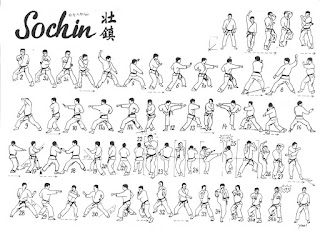Kumite
Sparring in Karate is called kumite. It literally means "meeting of hands." Kumite is practiced both as a sport and as self-defense training.
Levels of physical contact during sparring vary considerably. Full contact karate has several variants. Knockdown karate (such as Kyokushin) uses full power techniques to bring an opponent to the ground. In kickboxing variants (for example K-1), the preferred win is by knockout. Sparring in armour, bogu kumite, allows full power techniques with some safety. Sport kumite in many international competition under the World Karate Federation is free or structured with light contact or semi contact and points are awarded by a referee.
In structured kumite (yakusoku, prearranged), two participants perform a choreographed series of techniques with one striking while the other blocks. The form ends with one devastating technique (hito tsuki).
In free sparring (Jiyu Kumite), the two participants have a free choice of scoring techniques. The allowed techniques and contact level are primarily determined by sport or style organization policy, but might be modified according to the age, rank and sex of the participants. Depending upon style, take-downs, sweeps and in some rare cases even time-limited grappling on the ground are also allowed.
Free sparring is performed in a marked or closed area. The bout runs for a fixed time (2 to 3 minutes.) The time can run continuously (iri kume) or be stopped for referee judgment. In light contact or semi contact kumite, points are awarded based on the criteria: good form, sporting attitude, vigorous application, awareness/zanshin, good timing and correct distance. In full contact karate kumite, points are based on the results of the impact, rather than the formal appearance of the scoring technique.
after doing stretching exercises kihon on Kihon Shotokan Style : Learning Karate At Home (1.1) and then kata on Kata Shotokan Style : Learning Karate At Home (1.2). You can learn kumite. look for videos and sparing karate bunkai. to learn kumite. Because basically you've learned in kihon movements and kata.
Warning: Do not do kumite with people who are older people or small children. Make kumite training with people who already understand karate. Even if no one karate expert. You can practice it with adults with slow motion and is not recommended to use the technique of slamming due to kickback techniques must know how to fall right to perform technique dings should be doing karate club
This is some videos kumite :
- https://www.youtube.com/watch?v=p7nwAko4Wyk
- https://www.youtube.com/watch?v=4qd5DY6sGLk
- https://www.youtube.com/watch?v=cflWnX5kzRY
- https://en.wikipedia.org/wiki/Karate
- Pics from google search








































